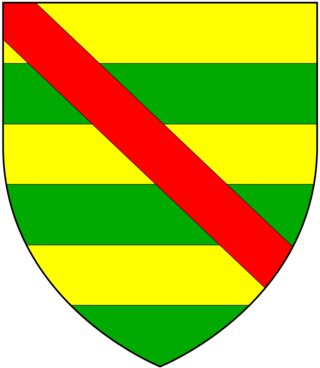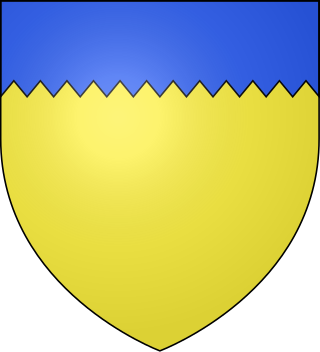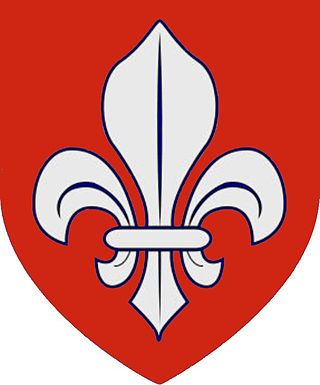
Francis Lovell, 9th Baron Lovell, 6th Baron Holand, later 1st Viscount Lovell, KG was an English nobleman who was an ally of King Richard III during the War of the Roses. Sir William Catesby, Sir Richard Ratcliffe and he were among Richard's closest supporters, famously called "the Cat, the Rat and Lovell our dog" in an anti-Ricardian squib. In addition to being an ally, Lovell is described as Richard's best friend.

Earl of Leicester is a title that has been created seven times. The first title was granted during the 12th century in the Peerage of England. The current title is in the Peerage of the United Kingdom and was created in 1837.
The title of Baron Grey of Codnor is a title in the peerage of England.

Baron Willoughby de Eresby is a title in the Peerage of England. It was created in 1313 for Robert de Willoughby. Since 1983, the title has been held by Jane Heathcote-Drummond-Willoughby, 28th Baroness Willoughby de Eresby.

Baron Wharton is a title in the Peerage of England, originally granted by letters patent to the heirs male of the 1st Baron, which was forfeited in 1729 when the last male-line heir was declared an outlaw. The Barony was erroneously revived in 1916 by writ of summons, thanks to an 1844 decision in the House of Lords based on absence of documentation. As such, the current Barony of Wharton could more accurately be listed as a new Barony, created in 1916, with the precedence of the older Barony.

Baron Stafford, referring to the town of Stafford, is a title that has been created several times in the Peerage of England. In the 14th century, the barons of the first creation were made earls. Those of the fifth creation, in the 17th century, became first viscounts and then earls. Since 1913, the title has been held by the Fitzherbert family.

Baron Strange is a title which has been created four times in the Peerage of England. Two creations, one in 1295 and another in 1326, had only one holder each, upon whose deaths they became extinct. Two of the creations, that of 1299 and that of 1628, are extant. The surname Le Strange was Latinized as Extraneus. The arms of Le Strange of Knockin Castle in Shropshire were: Gules, two lions passant argent.
Baron Lisle was a title which was created five times in the Peerage of England during the Middle Ages and Tudor period, and once in the Peerage of Ireland in the 18th century.
Baron Beaumont is an ancient title in the Peerage of England, created in 1309 for a younger branch of the French counts of de Brienne family. The sixth Baron Beaumont was created Viscount Beaumont in 1432; after the death of his son the 2nd Viscount both titles fell into abeyance.
The title Baron Norreys of Rycote was created in the Peerage of England by writ for Sir Henry Norris in 1572. The 2nd Baron Norreys was created Viscount Thame and Earl of Berkshire, both titles became extinct on his death. After two female heirs in the 17th century, the barony of Norreys went to the family of Bertie, and its holder, the 5th Baron Norreys became Earl of Abingdon in 1682. Since that time, the barony Norreys of Rycote has been a subsidiary title of the Earls of Abingdon, who have become Earls of Lindsey in the 20th century.

Under feudalism in France and England during the Middle Ages, tenure by serjeanty was a form of tenure in return for a specified duty other than standard knight-service.

Sir Miles Stapleton, KG was Lord of the Manor of Ingham, Norfolk and de jure Baron Ingham of Ingham, Norfolk, and Lord of the Manor of Bedale, Yorkshire.
William Bardolf, 4th Baron Bardolf and 3rd Baron Damory of Wormegay, Norfolk, was an extensive landowner in Norfolk, Lincolnshire, Suffolk and Surrey. He was the son of John Bardolf, 3rd Baron Bardolf and Elizabeth Damory, suo jure 2nd Baroness Damory. His maternal grandparents were Sir Roger Damory, Lord Damory and Lady Elizabeth de Clare, a granddaughter of King Edward I. In 1372, Bardolf had livery of his lands from the Crown - See.

Michael de Poynings, 1st Baron Poynings, Knt., of Bures St. Mary, Suffolk, was an English nobleman and soldier. He was present at the Battle of Crécy.

The title Baron Moels was created once in the Peerage of England, in 1299, and passed into abeyance with the death of the fourth lord in 1337. The four men who by modern usage are held to have been Barons Moels were:
John Bardolf, 3rd Baron Bardolf, Knight Banneret,, was a baron in the Peerage of England. He was the son of Thomas Bardolf, 2nd Baron Bardolf and Agnes Grandison, thought to be the daughter of William de Grandison, 1st Baron Grandison.

Butler is the name of a noble family whose members were, for several centuries, prominent in the administration of the Lordship of Ireland and the Kingdom of Ireland. They rose to their highest prominence as Dukes of Ormonde. The family has produced multiple titles such as Baron Cahir, Baron Dunboyne, Viscount Ikerrin, Viscount Galmoye, Viscount Mountgarret, Viscount Thurles, Earl of Carrick, Earl of Kilkenny, Earl of Ormond, Earl of Ossory, Marquess of Ormonde and Duke of Ormonde. Variant spellings of the name include le Boteler and le Botiller. The Butlers were descendants of Anglo-Norman lords who participated in the Norman invasion of Ireland in the 12th century. The surname has its origins in the hereditary office of "Butler (cup-bearer) of Ireland", originating with Theobald Walter, 1st Chief Butler of Ireland. The arms of later family members depicted three cups in recognition of their original office.

The Aguillon family, of French origin, were feudal landowners in England who held estates in several southern counties from before 1135 to 1312. Surviving records suggest various branches which all ended without male heirs, the lands going to daughters or sisters and their husbands. The family seems to have been initially associated, perhaps as under-tenants and maybe through marriage, with the Marmion family, witnessing charters alongside them in Normandy in 1106 and later occupying their land in England.

Dillegrout or dilligrout is a dish traditionally presented at the coronations of kings and queens of England by the holders of the manor of Addington in a kitchen serjeanty. It is generally thought to be a soup or stew made from almond milk, capon, sugar, and spices, but a porridge-like dish of other ingredients has been described. Dillegrout was first presented in 1068 at the coronation of Matilda of Flanders, wife of William the Conqueror, and its final presentation was at the coronation of George IV in 1821.

Hugh Bardolf, 1st Baron Bardolf, Lord of Wormegay was an English noble. He served in the wars in France and Scotland and was a signatory of the Baron's Letter to Pope Boniface VIII in 1301.













